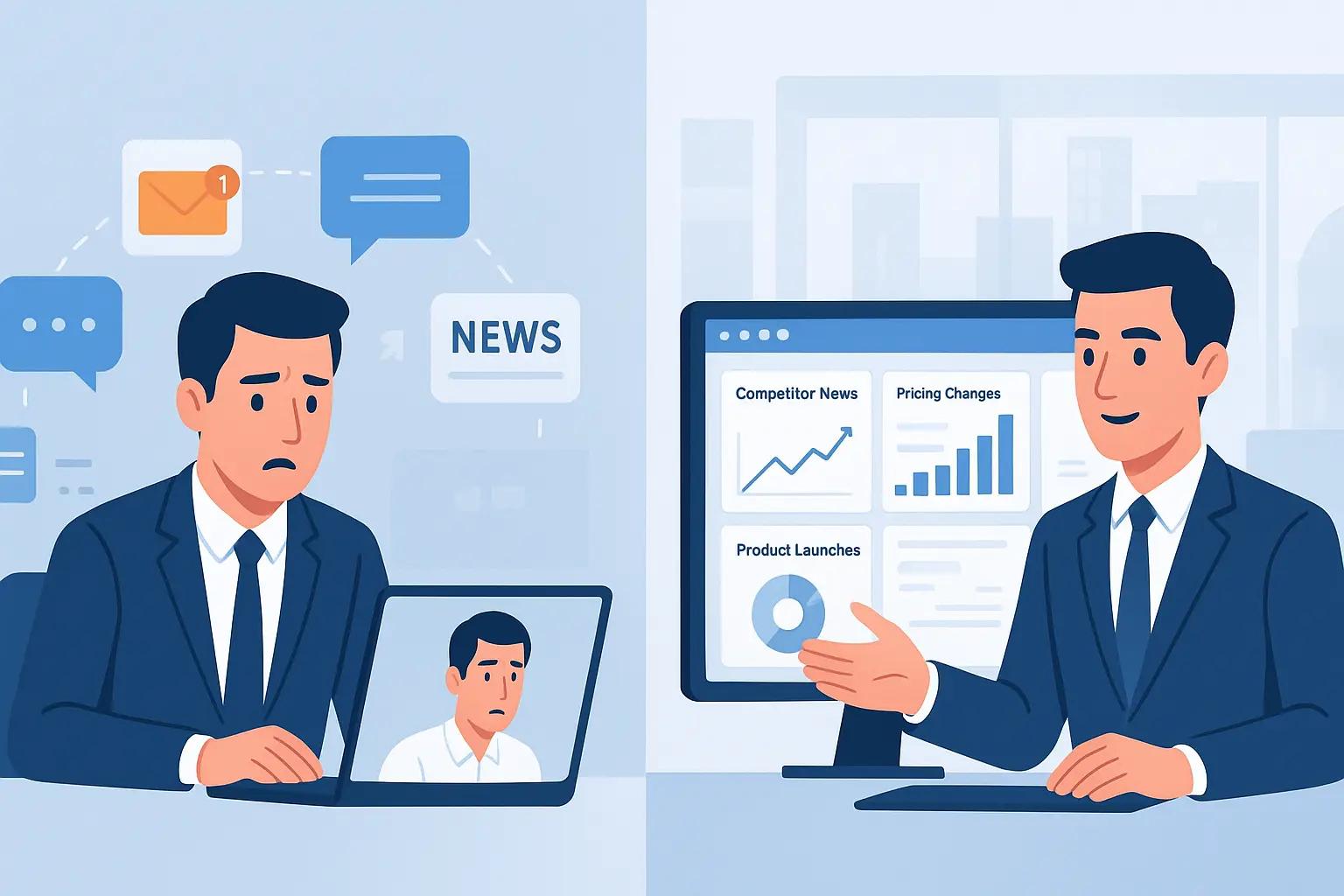The $1.2 Trillion Problem: When Sales Teams Fall Behind
A frustrated sales director recently shared a painful reality on Reddit: their top sales rep walked into a major pitch completely unaware that a competitor had launched the exact feature they were proposing—just one week earlier. The awkward silence that followed cost them not just the deal, but credibility with a key prospect.
This scenario plays out thousands of times daily across industries. According to Salesforce research, sales teams that lack real-time market intelligence lose 27% more deals to competitors who stay current with market changes. The cost? An estimated $1.2 trillion in lost revenue annually across B2B markets.
The Reddit discussion from r/sales highlighted a critical challenge facing modern sales organizations: how to keep distributed teams informed about rapid market changes without destroying productivity. Traditional communication methods—emails, Slack messages, and all-hands meetings—are failing to deliver timely, actionable intelligence to sales professionals when they need it most.
For e-commerce and retail businesses especially, this intelligence gap becomes even more costly. When sales teams can’t provide real-time product updates, competitive comparisons, or market insights during customer interactions, conversion rates suffer and customer confidence erodes.
The Anatomy of Sales Intelligence Breakdown
The Speed of Market Change vs. Information Distribution
Modern markets move at unprecedented speed. Product launches, pricing changes, feature updates, and competitive moves happen weekly—sometimes daily. Yet most sales organizations still rely on monthly newsletters, quarterly training sessions, and annual conferences to share market intelligence.
The reality of market velocity:
- Product Updates: B2B SaaS companies release features every 2-4 weeks
- Pricing Changes: Competitors adjust pricing monthly on average
- Market News: Industry-relevant news breaks every 1-2 days
- Regulatory Updates: Compliance changes affect sales messaging quarterly
Traditional communication response times:
- Email Announcements: 48-72 hours to reach all team members
- Slack Updates: 60% of team members miss messages within 24 hours
- Team Meetings: Weekly at best, often bi-weekly or monthly
- Training Sessions: Quarterly updates, months behind market reality
This mismatch creates a dangerous lag where sales teams operate on outdated information, making them vulnerable to competitors who maintain real-time market awareness.
The Distributed Team Challenge
The shift to remote and hybrid work models has amplified the sales intelligence challenge. Distributed teams lack the informal knowledge sharing that happens naturally in office environments—the hallway conversations, impromptu briefings, and shared workspace awareness that historically kept sales teams synchronized.
Key challenges for distributed sales teams:
Information Silos: Different team members receive different information through various channels, creating inconsistent market knowledge across the organization.
Time Zone Barriers: Global teams struggle to participate in real-time briefings, often receiving critical updates hours or days after they become relevant.
Context Loss: Written communications lack the nuance and context that come with face-to-face discussions, leading to misinterpretation of market signals.
Follow-up Gaps: Without immediate clarification opportunities, sales reps often proceed with incomplete or incorrect understanding of market changes.
The Productivity Paradox
Sales managers face an impossible choice: interrupt productive selling time with frequent updates, or risk having uninformed reps lose deals to better-prepared competitors. This productivity paradox forces most organizations to choose reactive communication over proactive intelligence sharing.
The true cost of information gaps:
- Lost Deals: 27% higher loss rate when competitors have better market intelligence
- Reduced Confidence: Sales reps avoid competitive situations when they feel uninformed
- Longer Sales Cycles: Additional research and internal consultations extend deal timelines
- Customer Trust Issues: Uninformed reps damage brand credibility with prospects
Market Intelligence: From Reactive to Proactive Systems
The Evolution of Sales Enablement Technology
Forward-thinking organizations are moving beyond traditional communication methods to implement intelligent systems that deliver relevant market updates contextually during customer interactions.
Traditional Approach Limitations:
- Push Communication: Information sent whether relevant or not
- Generic Updates: Same message for all team members regardless of territory or specialty
- Timing Disconnect: Updates arrive when convenient for senders, not receivers
- Context Absence: Information lacks relevance to current customer conversations
Modern Intelligence Systems Characteristics:
- Pull-Based Information: Reps access relevant intelligence when needed
- Contextual Delivery: Updates tied to specific customer interactions or market segments
- Real-Time Integration: Information delivered during live customer conversations
- Personalized Filtering: Content customized based on rep territory, products, and customer type
Competitive Intelligence Automation
The most sophisticated sales organizations now use AI-powered systems to monitor competitor activities, market changes, and industry news automatically. These systems provide several advantages over manual intelligence gathering:
Automated Market Monitoring:
- Competitor Website Tracking: Automatic detection of new products, pricing changes, and messaging updates
- News Aggregation: Industry-relevant news filtered and summarized for sales context
- Social Media Monitoring: Competitive mentions, customer feedback, and market sentiment tracking
- Regulatory Watching: Compliance changes that affect sales messaging and positioning
Intelligent Distribution:
- Role-Based Filtering: Information customized for different sales roles and responsibilities
- Territory Relevance: Geographic and market-specific intelligence for regional teams
- Customer Matching: Updates relevant to specific customer types or industry segments
- Urgency Prioritization: Critical updates flagged for immediate attention
Real-Time Customer Interaction Enhancement
The most innovative approach involves integrating market intelligence directly into customer-facing interactions. Rather than hoping sales reps remember briefing information, these systems provide relevant intelligence contextually during live conversations.
Contextual Intelligence Delivery:
- Customer-Specific Insights: Relevant competitive information based on prospect industry and needs
- Product Comparison Data: Real-time competitive analysis during product demonstrations
- Market Trend Integration: Industry insights woven into customer conversations naturally
- Regulatory Compliance: Automatic inclusion of relevant compliance information in sales messaging
Implementation Strategies for Sales Intelligence Systems
Phase 1: Assessment and Foundation Building (30-60 Days)
Current State Analysis The first step involves understanding existing information flows and identifying specific gaps in market intelligence distribution. This assessment should examine:
Communication Channel Audit: Document all current methods for sharing market updates, measuring reach, engagement, and retention rates for each channel.
Information Source Mapping: Identify where market intelligence originates—product teams, marketing, competitive intelligence, industry analysts—and how it flows to sales teams.
Gap Analysis: Survey sales teams to understand what information they need, when they need it, and how current systems are failing to meet those needs.
Competitive Loss Analysis: Review lost deals to identify patterns where better market intelligence could have changed outcomes.
Technology Infrastructure Review: Assess existing CRM, sales enablement, and communication systems to understand integration possibilities.
Phase 2: System Design and Integration (60-90 Days)
Intelligence Source Integration Successful sales intelligence systems aggregate information from multiple sources and present it in unified, actionable formats:
Internal Sources: Product roadmaps, pricing strategies, marketing messaging, customer success insights, and support team feedback.
External Sources: Industry publications, competitor websites, social media monitoring, analyst reports, and regulatory bodies.
Customer Sources: Feedback from current customers, prospect conversations, and market research data.
Partner Sources: Channel partner insights, vendor relationships, and industry network intelligence.
Delivery Mechanism Development The system must deliver relevant information at the right time through the right channels:
CRM Integration: Embed relevant competitive intelligence directly into customer records and opportunity management workflows.
Mobile Accessibility: Ensure sales reps can access critical information from mobile devices during customer meetings and travel.
Conversation Support: Provide real-time assistance during customer calls, including suggested talking points and competitive responses.
Offline Capability: Enable access to key information even when internet connectivity is limited.
Phase 3: Advanced Analytics and Optimization (90+ Days)
Intelligence Effectiveness Measurement Successful systems continuously measure and optimize the impact of market intelligence on sales performance:
Usage Analytics: Track which information sources are most valuable to different team members and customer situations.
Outcome Correlation: Measure the relationship between intelligence consumption and deal outcomes.
Feedback Integration: Collect ongoing input from sales teams about information relevance and timing.
Competitive Win Rate Analysis: Monitor improvements in competitive situations where better intelligence is available.
Predictive Intelligence Development Advanced systems begin predicting what information sales teams will need based on customer interactions, market patterns, and historical data:
Customer Journey Mapping: Anticipate information needs based on prospect behavior and sales stage.
Seasonal Intelligence: Prepare relevant market updates based on historical patterns and upcoming events.
Territory-Specific Predictions: Customize intelligence based on regional market conditions and competitive landscapes.
Account-Based Intelligence: Develop specific competitive and market insights for high-value target accounts.
Technology Solutions for Modern Sales Intelligence
Conversational Commerce Integration
The most innovative approach to sales intelligence involves embedding market knowledge directly into customer conversations through conversational commerce platforms. This method eliminates the gap between information availability and application by providing contextual intelligence during live customer interactions.
Real-Time Intelligence Delivery:
- Product Demonstration Enhancement: Automatic integration of latest features and competitive advantages during live product demos
- Objection Handling Support: Instant access to competitive responses and market positioning during customer conversations
- Pricing Intelligence: Real-time competitive pricing information available during quote discussions
- Feature Comparison: Side-by-side competitive analysis available during customer consultations
Customer Interaction Analytics:
- Conversation Intelligence: Analysis of customer interactions to identify intelligence gaps and information needs
- Competitive Mention Tracking: Monitoring when and how competitors are discussed in customer conversations
- Market Trend Integration: Customer questions and concerns that reveal market shifts and opportunities
- Success Pattern Recognition: Identifying which market intelligence leads to successful customer outcomes
AI-Powered Market Monitoring
Artificial intelligence transforms market monitoring from manual research to automated intelligence gathering that operates continuously across multiple sources:
Automated Content Analysis:
- Competitor Website Monitoring: AI systems that detect and analyze changes to competitor websites, documentation, and marketing materials
- News and Media Tracking: Natural language processing that identifies relevant industry news and competitive developments
- Social Media Intelligence: Sentiment analysis and trend identification from social media conversations about competitors and market conditions
- Patent and Filing Monitoring: Tracking of intellectual property filings that reveal competitor development directions
Predictive Market Analysis:
- Trend Forecasting: AI models that predict market movements based on historical patterns and current indicators
- Competitive Move Prediction: Analysis of competitor behavior patterns to anticipate future actions
- Customer Demand Modeling: Predictive analytics that identify shifting customer preferences and market opportunities
- Risk Assessment: Early warning systems for market changes that could impact sales effectiveness
Integration with Customer Relationship Management
Modern sales intelligence systems seamlessly integrate with existing CRM platforms to provide contextual information without requiring additional tools or workflow disruptions:
Opportunity Intelligence:
- Account-Specific Insights: Relevant competitive and market information automatically associated with customer records
- Deal Stage Optimization: Information delivery timed to match sales process stages and customer decision points
- Stakeholder Analysis: Intelligence about decision-makers, influencers, and competitive preferences within target accounts
- Historical Context: Previous interactions and intelligence that inform current customer conversations
Performance Enhancement:
- Activity Correlation: Connecting intelligence consumption with sales activities and outcomes
- Coaching Integration: Enabling sales managers to provide targeted coaching based on intelligence utilization
- Skill Development: Identifying areas where additional market knowledge or competitive training is needed
- Best Practice Sharing: Distributing successful intelligence application examples across the sales organization
Measuring the Impact of Sales Intelligence Systems
Primary Performance Indicators
Competitive Win Rate Improvement The most direct measure of sales intelligence effectiveness is improvement in competitive situations. Organizations with effective intelligence systems typically see:
- Head-to-Head Comparisons: 15-25% improvement in win rates when competing directly against known competitors
- Objection Handling: 30-40% reduction in unresolved competitive objections during sales conversations
- Sales Cycle Compression: 20-30% faster deal closure when reps have access to real-time market intelligence
- Deal Size Growth: 10-15% increase in average deal size through better competitive positioning
Customer Engagement Quality Market intelligence directly impacts the quality and effectiveness of customer interactions:
- Conversation Relevance: 40-50% improvement in customer-perceived value of sales conversations
- Trust Building: 35-45% increase in customer confidence levels during sales processes
- Referral Generation: 25-30% more customer referrals from better-informed sales interactions
- Customer Satisfaction: 20-25% improvement in post-sales customer satisfaction scores
Advanced Analytics and ROI Measurement
Revenue Attribution Advanced measurement systems track the direct revenue impact of intelligence investments:
- Intelligence-Influenced Revenue: Tracking deals where market intelligence played a documented role in success
- Competitive Displacement: Revenue captured from competitors through better market positioning
- Upsell and Cross-sell Enhancement: Additional revenue from intelligence-informed expansion conversations
- Customer Lifetime Value Impact: Long-term revenue improvements from better initial positioning
Operational Efficiency Gains Intelligence systems create operational benefits beyond direct revenue impact:
- Research Time Reduction: 50-70% decrease in time spent researching competitive and market information
- Training Efficiency: 40-60% reduction in time required to onboard new sales team members
- Management Overhead: 30-50% decrease in time spent briefing teams on market changes
- Information Quality: 60-80% improvement in accuracy of competitive information used in sales processes
The Future of Sales Intelligence: Predictive and Contextual
Emerging Technologies and Capabilities
Artificial Intelligence Integration The next generation of sales intelligence systems leverages advanced AI to provide predictive insights and automated intelligence gathering:
Natural Language Processing: AI systems that understand customer conversations and automatically surface relevant competitive and market information during calls.
Predictive Analytics: Machine learning models that anticipate customer needs and competitive threats based on market patterns and historical data.
Automated Content Generation: AI-powered creation of competitive battle cards, market briefings, and customer-specific intelligence summaries.
Sentiment Analysis: Real-time analysis of market sentiment and customer feedback to identify opportunities and threats before they become obvious.
Conversational Commerce Evolution
The convergence of sales intelligence and conversational commerce creates unprecedented opportunities for competitive advantage:
Contextual Intelligence Delivery: Market information delivered precisely when needed during customer conversations, eliminating the need for separate research and briefing processes.
Real-Time Competitive Positioning: Automatic adjustment of product positioning and messaging based on current competitive landscape and customer-specific factors.
Dynamic Pricing Intelligence: AI-powered pricing recommendations based on real-time competitive analysis and customer value perception.
Predictive Objection Handling: Anticipation of customer concerns and competitive challenges with pre-prepared, contextually relevant responses.
Strategic Implementation Recommendations
For Sales Leadership
Executive Commitment to Intelligence Investment Sales intelligence systems require sustained investment and organizational commitment to deliver maximum value. Leadership must:
Budget Allocation: Dedicate 3-5% of sales technology budget specifically to intelligence systems and market monitoring capabilities.
Performance Integration: Include intelligence utilization and competitive win rates in sales team performance metrics and compensation plans.
Cultural Change Management: Foster a culture that values continuous market learning and information sharing across the sales organization.
Cross-Functional Collaboration: Establish formal processes for sharing intelligence between sales, marketing, product, and customer success teams.
For Sales Operations Teams
System Integration and Optimization Operations teams play a critical role in making intelligence systems effective and user-friendly:
Technology Stack Integration: Ensure seamless integration between intelligence systems, CRM platforms, and existing sales tools.
User Experience Design: Optimize information delivery to minimize disruption to sales workflows while maximizing intelligence accessibility.
Data Quality Management: Implement processes to ensure intelligence accuracy, relevance, and timeliness across all information sources.
Performance Monitoring: Establish metrics and reporting systems to track intelligence system usage and impact on sales outcomes.
For Individual Sales Professionals
Intelligence Utilization Best Practices Sales professionals must develop new skills and habits to maximize the value of available market intelligence:
Proactive Information Consumption: Establish regular routines for consuming market updates and competitive intelligence before customer interactions.
Contextual Application: Learn to weave market insights naturally into customer conversations without overwhelming prospects with information.
Feedback Contribution: Actively share customer insights and competitive intelligence gathered during sales activities with broader team.
Continuous Learning: Stay current with industry trends and competitive developments beyond formal intelligence systems.
Conclusion: From Information Gaps to Competitive Advantage
The Reddit discussion that inspired this analysis represents a wake-up call for sales organizations worldwide. The gap between market velocity and information distribution is not just an operational inconvenience—it’s a competitive threat that costs businesses billions in lost revenue annually.
Organizations that successfully bridge this intelligence gap don’t just improve their win rates; they fundamentally transform their competitive positioning. By implementing sophisticated market intelligence systems that deliver contextual information during customer interactions, these companies create sustainable competitive advantages that are difficult for rivals to replicate.
The solution isn’t just about faster communication or more frequent meetings. It requires a fundamental reimagining of how market intelligence flows through sales organizations, leveraging technology to eliminate the traditional barriers between information availability and application.
For sales leaders facing similar challenges, the path forward involves embracing intelligence systems that integrate seamlessly with customer-facing activities. The most successful implementations combine automated market monitoring, AI-powered analysis, and contextual delivery systems that enhance rather than disrupt existing sales workflows.
The competitive advantage goes to organizations that can turn their sales teams into informed, confident advocates who consistently demonstrate superior market knowledge during customer interactions. In an era where customers have access to unprecedented information, sales teams that lack real-time market intelligence become irrelevant.
The technology exists today to solve the intelligence gap crisis. The question isn’t whether these systems work—it’s how quickly organizations can implement them before competitors gain insurmountable advantages.
Book Your Live Demo to discover how Immerss transforms sales intelligence challenges into competitive advantages through AI-powered conversational commerce that delivers real-time market insights during every customer interaction.



